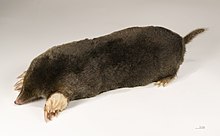Mole (animal)
| Moles | |
|---|---|
 |
|
| European mole | |
| Scientific classification | |
| Kingdom: | Animalia |
| Phylum: | Chordata |
| Class: | Mammalia |
| Infraclass: | Eutheria |
| Order: | Eulipotyphla |
| Family: |
Talpidae in part |
| Genera | |
|
12 genera, see text |
|
12 genera, see text
Moles are small mammals adapted to a subterranean lifestyle (i.e., fossorial). They have cylindrical bodies, velvety fur, very small, inconspicuous ears and eyes, reduced hindlimbs and short, powerful forelimbs with large paws adapted for digging. The term "mole" is especially and most properly used for "true moles" of the Talpidae family in the order Eulipotyphla found in most parts of North America,Asia, and Europe although may refer to other completely unrelated mammals of Australia and southern Africa that have also evolved the mole body plan; it is not commonly used for some talpids, such as desmans and shrew-moles, which do not quite fit the common definition of "mole".
In Middle English, moles were known as moldwarp. The expression "do not make a mountain out of a mole hill" – exaggerating problems – was first recorded in Tudor times. By the era of Early Modern English, the mole was also known in English as mouldywarp, a word having cognates in other Germanic languages such as German (Maulwurf), and Danish, Norwegian, Swedish and Icelandic (muldvarp, mullvad, moldvarpa), where the muld/mull/mold part of the word means soil and the varp/vad/varpa part means throw, hence "one who throws soil" or "dirt tosser".
Male moles are called "boars", females are called "sows". A group of moles is called a "labour".
...
Wikipedia
